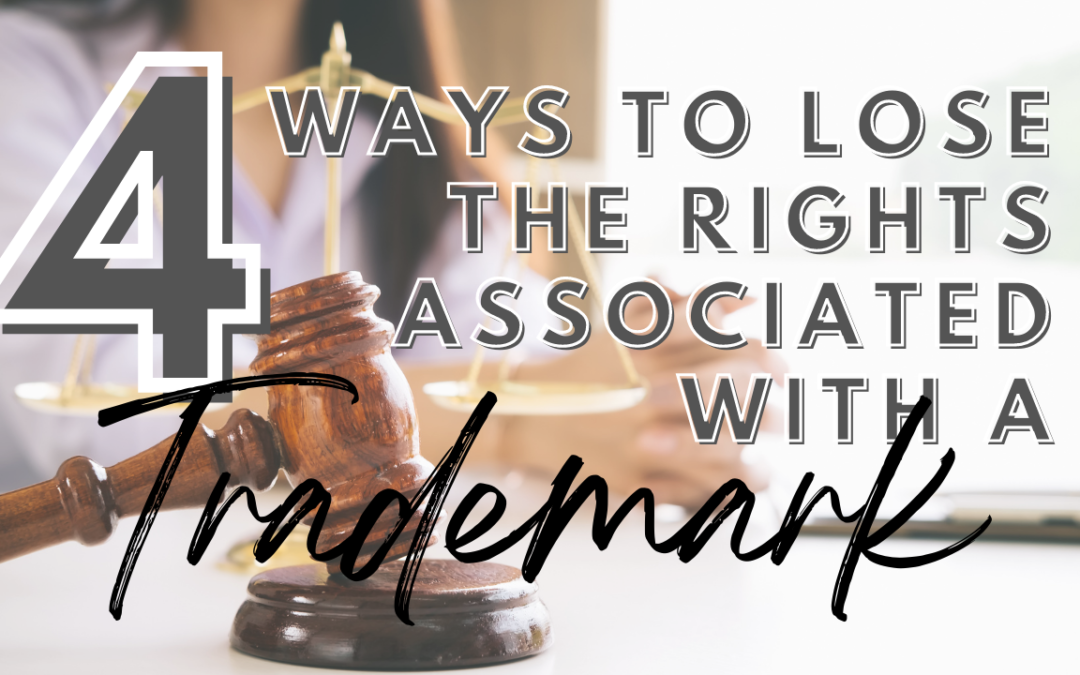Did you know that certain ways can lead you to to lose the rights associated with your trademark? It’s true! And if you’re an owner of a trademark, it’s important to be aware of them. A trademark can potentially be owned in perpetuity, but the lack of proper brand management, use, and legal guardrails can lead to the loss of a trademark.
In this blog, we’ll discuss the 4 most common ways you could lose the rights to the trademark and what you can do to prevent this from happening.
1. Abandonment
It is also termed as non-use of the trademark and it occurs when a trademark owner discontinues the use and displays no intent to resume the use of a trademark or even renew their trademark registration. After acquiring your registration, the certificate given by the United States Patent and Trademark Office (USPTO) is valid for ten years, after which it is imperative to renew it. Failing to do so amounts to non-use under the trademark law and you lose ownership of your trademark.
A discontinued use of the trademark for three consecutive years is also evidence, on its face, of non-use. The discontinuance requires a complete halt in the use and even a single good-faith use or receipt of royalties is enough to defend the claim of abandonment.
Most importantly, the tolerance of third-party use can also result in the same.
This is why a Trademark watch or monitoring service is a logical expense for most brands because it is the only way to know aside from setting up Google alerts that your brand is not infringed by another company. The importance of monitoring your trademarks after they’re registered cannot be overstated.
2. Lack of Distinctiveness
A trademark is deemed to become generic i.e. it no longer possesses distinctiveness when the primary significance of the mark to the consumer is diluted into the name of a type of product or service and not a source identifier. Now, remember, a generic mark can never receive intellectual property rights.
For example, Aspirin has been a registered Trademark since 1887 but is now considered common knowledge to most people who take medicine for pain relief. Dry Ice was originally patented in 1896 by JP Pethel under its current name of “Dry Icing” which provides an added benefit when applied topically as well. Motorola was the first company to coin and protect the term “flip phone,” but eventually it became a description of a type of phone instead of being a source identifier to Motorola.
You might be thinking: “What about Google?” People often use the term “Google” as a verb, meaning to search for something. But this doesn’t mean that the mark is now generic. In fact, in a case from 2017, the courts decided that the use of Google mark as a verb did not automatically constitute generic use. Even if most people used the mark as a verb in a generic and indiscriminate sense to refer to the act of searching. There was not sufficient evidence that the public used the mark as a generic name for internet search engines.
Hence, you are at risk of loss of trademark rights if it loses distinctiveness. As stated above, trademark owners must invest in a trademark monitoring service so that they can monitor any risk of trademark infringement or misuse beforehand and avoid losing their rights.
3. Naked Licensing
When a licensor licenses a mark without enforcing sufficient quality control over the goods or services provided under the mark, it is deemed that there has been a naked license.
The reason for naked licensing is that if the original owner of the trademark does not make sure that the same quality control is used over the goods or services, the mark no longer represents what people expect from it.
To demonstrate sufficient quality control over the licensee:
- The licensor must retain contractual rights over the use of its trademarks.
- The licensor must control the quality of the use of its trademarks.
- The licensor must have reasonably relied on the licensee to maintain that quality.
4. Assignment-in-Gross
The owner of trademark rights cannot sell their trademarks to another party without the marks being associated with goodwill. Goodwill is what allows people to continue purchasing the product or service because of their association with the trademark. For example, suppose a trademark owner sells their entire business. In that case, the trademarks and associated goodwill are assumed to have been sold unless there’s a statement by the seller that says otherwise.
As you can see, there are several ways to lose the trademark rights that you’ve worked so hard to build. By understanding these potential pitfalls and taking the necessary precautions against protecting your trademark, you will be able to keep your brand strong. If you have any questions or would like more information on how to protect your trademark. We would be happy to schedule a discovery call and discuss our trademark protection services in further detail. Thanks for reading!
If you’re experiencing challenges with protecting your trademark and would like help getting to the bottom of it, please don’t hesitate to contact us at Drishti Law. We’d be happy to schedule a discovery call with you. Our principal trademark attorney will discuss your situation in more detail and come up with a plan tailored specifically for you.

Sahil Malhotra
Sahil Malhotra is an Intellectual Property Attorney, who founded Drishti (“vision”) law because of his vision in protecting dreams and ideas.
He provided individuals and small businesses with an opportunity to enhance their IP’s value by helping them register trademarks and successfully argue against office actions. In addition to his training and experience, he has been deeply involved in the multifaceted IP portfolio at UIC and continues to be associated with IP organizations and conferences.
To know more about Sahil Malhotra — Click Here
You may follow Sahil Malhotra on Facebook: Sahil Malhotra and on Instagram: @Sahil Malhotra

